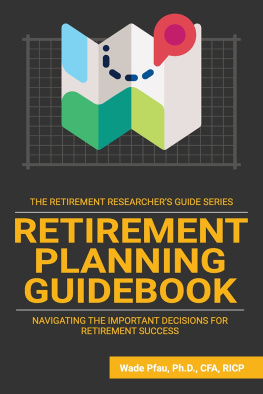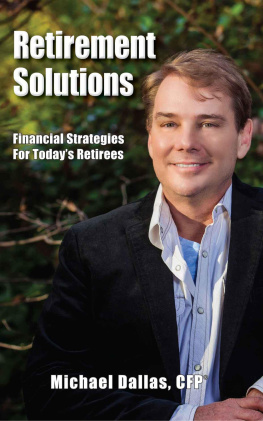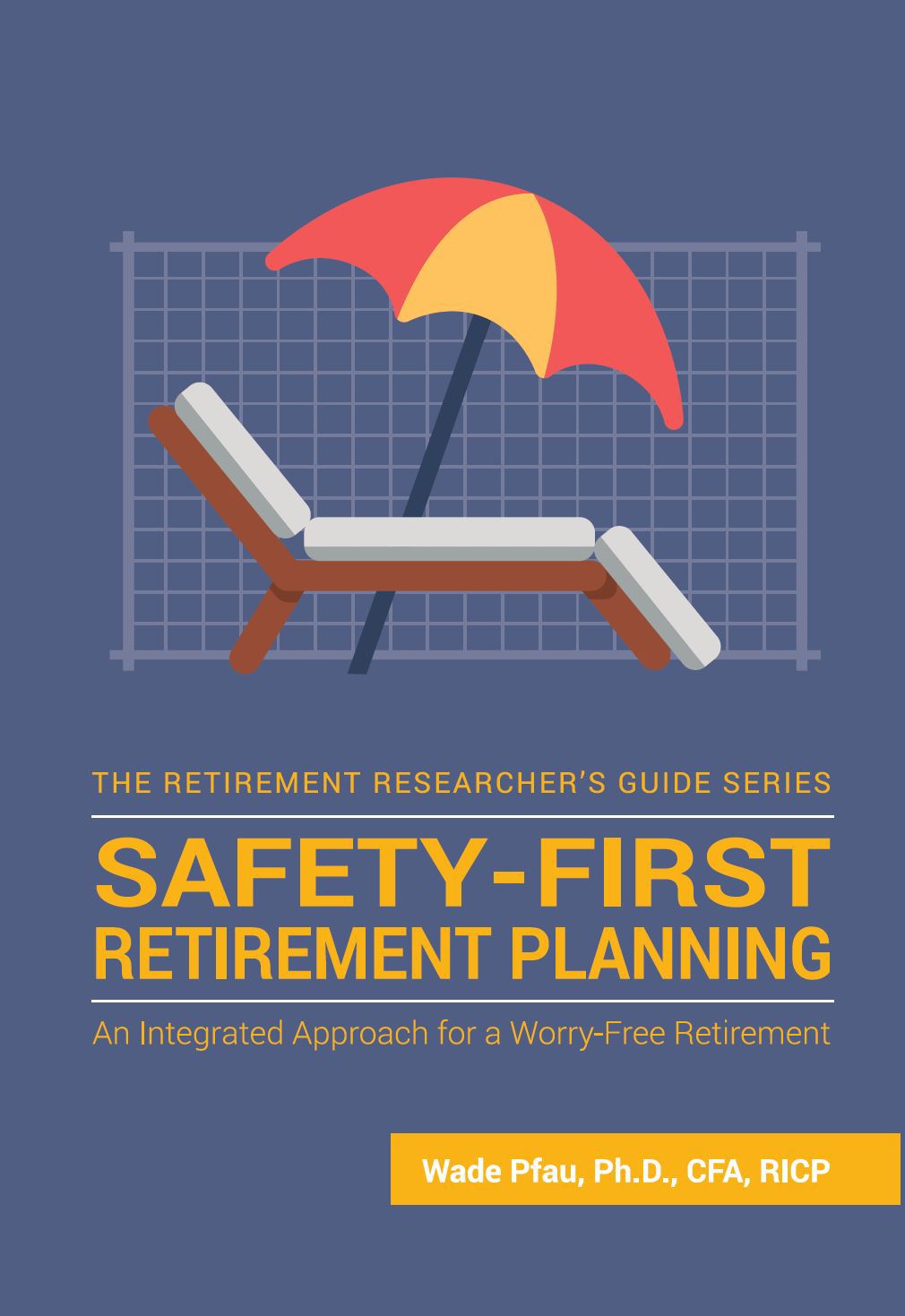The Retirement Researchers Guide Series
Safety-First Retirement Planning
An Integrated Approach for a Worry-Free Retirement
Wade D. Pfau, PhD, CFA, RICP
Copyright 2019 by Wade Donald Pfau. All rights reserved.
Published by Retirement Researcher Media, Vienna, Virginia.
No part of this publication may be reproduced, stored in a retrieval system, or transmitted in any form or by any means, electronic, mechanical, photocopying, recording, scanning, or otherwise, except as permitted under Section 107 or 108 of the 1976 United States Copyright Act, without the prior written permission of the publisher. Requests to the publisher for permission should be addressed to wade@retirementresearcher.com.
Limit of Liability/Disclaimer of Warranty: While the publisher and author have used their best efforts in preparing this book, they make no representations or warranties with respect to the accuracy or completeness of the contents of this book and specifically disclaim any implied warranties of merchantability or fitness for a particular purpose. No warranty may be created or extended by sales representatives or written sales materials. The advice and strategies contained herein may not be suitable for your situation. You should consult with a professional where appropriate. Neither the publisher nor the author shall be liable for any loss of profit or any other commercial damages, including but not limited to special, incidental, consequential, or other damages.
Library of Congress Cataloging-in-Publication Data:
Pfau, Wade D., 1977
Safety-First Retirement Planning: An Integrated Approach to Securely Reaching Lifetime Financial Goals / Wade D. Pfau.
pages cm
Includes index.
ISBN [978-1-945640-06-3] (paperback) - ISBN [978-1-945640-07-0] (e-book)
Library of Congress Control Number:2019912666
Retirement Researcher, Vienna, VIRGINIA
1. Retirement Planning. 2. Financial, Personal. I. Title.
Cover Design: Trevor Alexander and Mineral Interactive
Graphics and Layout: Watermark Design Services
Printed in the United States of America
To those hard workers seeking to someday
enjoy their retirement.
Table of Contents
Preface
The challenge in building an effective retirement income plan is to use available income tools and tactics in a strategic manner to meet the financial goals of retirement while also managing the risks confronting those goals. The financial goals of retirement include sustainably meeting a lifestyle spending goal for as long as one lives, providing a legacy for the family or community, and maintaining liquidity to cover unexpected expenses and contingencies in retirement.
Meanwhile, the three major categories of risk for a retirement income plan include longevity, market volatility, and spending shocks. Longevity risk is the possibility of living longer than planned, which could mean not having resources to maintain the retirees standard of living. Market volatility is the risk that poor market returns are realized, leading to a reduced portfolio value and a reduced ability to maintain the retirement standard of living. Taking distributions from investments in retirement further amplifies market risk by increasing the importance of the ordering of investment returns. This is called sequence-of-returns risk. Finally, spending shocks are the risk that expensive bills materialize, such as for long-term care or health care, which require large expenditures that deplete assets and reduce the ability to maintain lifestyle at later ages.
Retirement income planning is the field of financial planning which addresses this challenge. It is still a relative newcomer within financial services, and it continues to experience growing pains and disagreements about the best way to help retirees succeed. In reviewing existing approaches, I have identified two very distinct schools of thought for managing the finances of retirement.
First, probability-based advocates generally support using an aggressive investment portfolio with a large allocation to stocks to meet retirement goals. My earlier book How Much Can I Spend in Retirement? A Guide to Investment-Based Retirement Strategies provides an extensive investigation of probability-based approaches. With these investment solutions, a higher lifestyle may be supported if one is willing to spend and invest aggressively in the hope of subsequently earning higher market returns. Should decent market returns materialize, investment solutions can be sustained indefinitely while also helping to support legacy and liquidity. Probability-based advocates are generally comfortable with the expectation that decent returns will materialize such that these approaches will probably work just fine.
However, an investments-only mind-set is not the optimal way to build a retirement income plan. There are pitfalls in retirement that we are less familiar with during the accumulation years. Traditional wealth management is not equipped to handle longevity and sequence risk in a fulfilling way. Retirees must self-manage longevity and market risk, which means more assets are required to cover spending goals over an assumed long time horizon combined with the possibility that poor market returns chip away at the portfolio. Nonetheless, longevity protection is not guaranteed with investments and assets may not be available to support a long life or legacy. For retirees who are worried about outliving their assets and not successfully meeting their lifetime financial goals, probability-based strategies can become excessively conservative and stressful.
This book is primarily about the other school of thought: the safety-first approach to retirement income. Safety-first advocates support a more bifurcated approach to building retirement income plans that integrates investments with insurance, providing lifetime income protections. Probability-based advocates generally view annuities and life insurance as unnecessary in retirement. They see the stock market as a straightforward way to obtain superior retirement outcomes. Safety-first advocates disagree.
Risk pooling with insurance provides an alternative means for potentially earmarking fewer assets to cover lifetime spending goals, effectively reducing the potential overall cost of retirement. With risk pooling, one does not need to plan for the very expensive case of an extremely long life combined with poor market returns. Instead, the retiree pays an insurance premium that will provide a benefit to support spending if those risks materialize and retirement becomes more expensive. An unprotected investment portfolio may otherwise deplete. Insurance companies can pool sequence and longevity risks across a large base of retirees, allowing for retirement spending that is greater than the sustainable withdrawal rate from investments for someone self-managing these risks. When bonds are replaced with insurance-based risk pooling assets, retirees can improve the odds of meeting their spending goals while also supporting more legacy at the end of life, especially in the event of a longer-than-average retirement.
Lifetime income through insurance, whether that be annuities or life insurance, can help to manage market volatility and investment risks, to protect from longevity risk, to more efficiently earmark assets to cover retirement spending, to reduce the fear and worry that many have about outliving their assets in retirement, and to simplify the financial plan.











